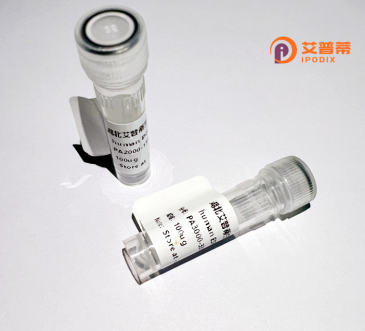
| 纯度 | >90%SDS-PAGE. |
| 种属 | Human |
| 靶点 | SFMBT1 |
| Uniprot No | Q9UHJ3 |
| 内毒素 | < 0.01EU/μg |
| 表达宿主 | E.coli |
| 表达区间 | 1-866 aa |
| 活性数据 | MNGEQQLDADAGSGMEEVELSWEDYLEETGSTAVPYGSFKHVDTRLQNGFAPGMKLEVAVRTDPETYWVATVITTCEQLLLLRYDGYGEDRRADFWCDIRKADLYPIGWCEQNKKTLEAPEGIRDKVSDWDEFLRQTLIGACSPPVPLLEGLRNGRNPLDLIAPGSRLECQAFQDSLSTWIVTVVENIGGRLKLRYEGLESSDNYEHWLYYLDPFLHHVGWAAQQGYELQPPSAIRHLKNEAEWQEILAKVKEEEEEPLPSYLFKDKQVIGIHTFSVNMKLEAVDPWSPFGISPATVVKVFDEKYFLVEMDDLRPENHARRSFVCHADSPGIFPVQWSLKNGLHISPPPGYPSQDFDWADYLKQCGAEAAPQRCFPPLISEHEFKENMKLEAVNPILPEEVCVATITAVRGSYLWLQLEGSKKPIPECIVSVESMDIFPLGWCETNGHPLSTPRRARVYKQRKIAVVQPEKQVPSSRTVHEGLRNQELNSTESVMINGKYCCPKIYFNHRCFSGPYLNKGRIAELPQCVGPGNCVLVLREVLTLLINAAYKPSRVLRELQLDKDSVWHGCGEVLKAKYKGKSYRATVEIVKTADRVTEFCRQTCIKLECCPNLFGPRMVLDKCSENCSVLTKTKYTHYYGKKKNKRIGRPPGGHSNLACALKKASKRRKRRKNVFVHKKKRSSASVDNTPAGSPQGSGGEDEDDPDEGDDDSLSEGSTSEQQDELQEESEMSEKKSCSSSPTQSEISTSLPPDRQRRKRELRTFSFSDDENKPPSPKEIRIEVAERLHLDSNPLKWSVADVVRFIRSTDCAPLARIFLDQEIDGQALLLLTLPTVQECMDLKLGPAIKLCHHIERIKFAFYEQFAN |
| 分子量 | 124.5 kDa |
| 蛋白标签 | GST-tag at N-terminal |
| 缓冲液 | PBS, pH7.4, containing 0.01% SKL, 1mM DTT, 5% Trehalose and Proclin300. |
| 稳定性 & 储存条件 | Lyophilized protein should be stored at ≤ -20°C, stable for one year after receipt. Reconstituted protein solution can be stored at 2-8°C for 2-7 days. Aliquots of reconstituted samples are stable at ≤ -20°C for 3 months. |
| 复溶 | Always centrifuge tubes before opening.Do not mix by vortex or pipetting. It is not recommended to reconstitute to a concentration less than 100μg/ml. Dissolve the lyophilized protein in distilled water. Please aliquot the reconstituted solution to minimize freeze-thaw cycles. |
以下是关于重组人SFMBT1蛋白的模拟参考文献示例(实际引用需核实原文):
1. **标题**: "SFMBT1 recruits the CoREST complex to regulate histone modifications and repress transcription"
**作者**: Li, Y., et al.
**摘要**: 研究揭示SFMBT1通过MBT结构域识别组蛋白H3K4甲基化,招募CoREST复合物(含HDAC1/2),协同抑制神经元基因表达。重组SFMBT1蛋白被用于体外结合实验,证实其与CoREST的相互作用。
2. **标题**: "Structural basis of histone binding by the human polycomb-like protein SFMBT1"
**作者**: Zhang, R., et al.
**摘要**: 通过X射线晶体学解析重组人SFMBT1蛋白的MBT结构域,揭示其选择性结合H3K4me1/2和H4K20me2的分子机制,为SFMBT1在表观遗传沉默中的作用提供结构基础。
3. **标题**: "SFMBT1 regulates proliferation and apoptosis in cancer cells via epigenetic modulation"
**作者**: Tanaka, K., et al.
**摘要**: 利用重组SFMBT1蛋白进行功能研究,发现其过表达通过抑制促凋亡基因(如BAX)的启动子活性,促进肿瘤细胞增殖,提示其在癌症中的潜在治疗靶点作用。
4. **标题**: "Recombinant expression and purification of human SFMBT1 for chromatin interaction assays"
**作者**: Müller, P., & Schmidt, A.
**摘要**: 描述在大肠杆菌中高效表达可溶性SFMBT1全长重组蛋白的优化策略,并应用该蛋白进行染色质下拉实验,验证其与特定基因启动子区域的结合能力。
**注意事项**:以上内容为模拟示例,实际文献需通过学术数据库(如PubMed、Web of Science)检索确认。建议使用关键词“SFMBT1 recombinant”或“SFMBT1 protein”进行精准查询。
**Background of Recombinant Human SFMBT1 Protein**
Scm-like with four MBT domains protein 1 (SFMBT1) is a member of the polycomb group (PcG) protein family, which plays a critical role in epigenetic regulation by modulating chromatin structure and gene silencing. It contains four malignant brain tumor (MBT) repeat domains, known to bind methylated histone residues (e.g., H3K9me2/3. H4K20me2/3), facilitating its interaction with repressive chromatin marks. SFMBT1 functions as part of the Polycomb repressive complex 1 (PRC1), contributing to transcriptional repression and maintenance of cellular identity during development.
Studies suggest SFMBT1 is involved in stem cell pluripotency, differentiation, and oncogenesis. It has been implicated in cancer progression, particularly in prostate cancer and glioblastoma, where aberrant expression correlates with tumor aggressiveness and poor prognosis. Recombinant human SFMBT1 protein is generated using heterologous expression systems (e.g., *E. coli* or mammalian cells) and purified for functional studies. It serves as a tool to investigate SFMBT1’s biochemical properties, histone-binding specificity, and interactions with partner proteins.
Research on recombinant SFMBT1 enhances understanding of its role in chromatin remodeling, epigenetic dysregulation in diseases, and potential therapeutic targeting. Its structural analysis and *in vitro* assays also aid in developing inhibitors or modulators of PcG-mediated gene silencing pathways.
×